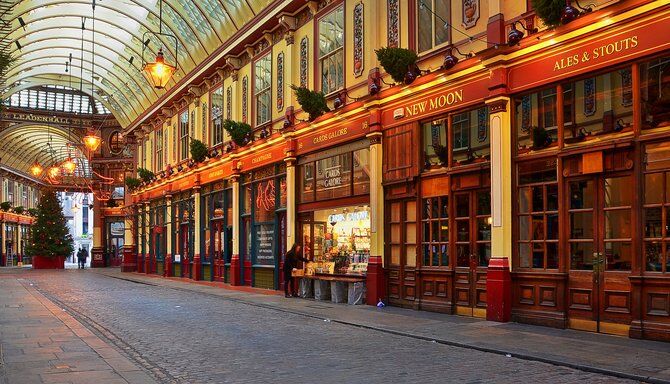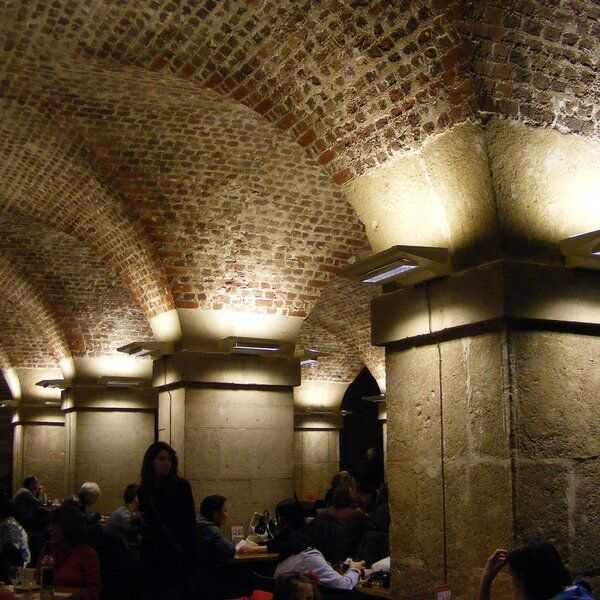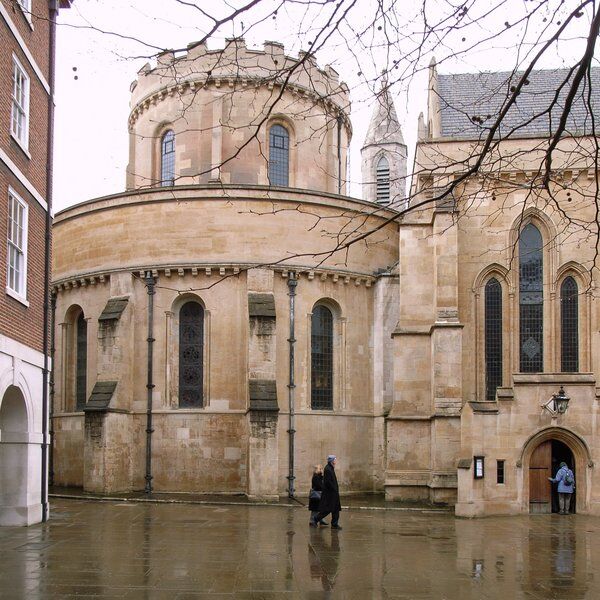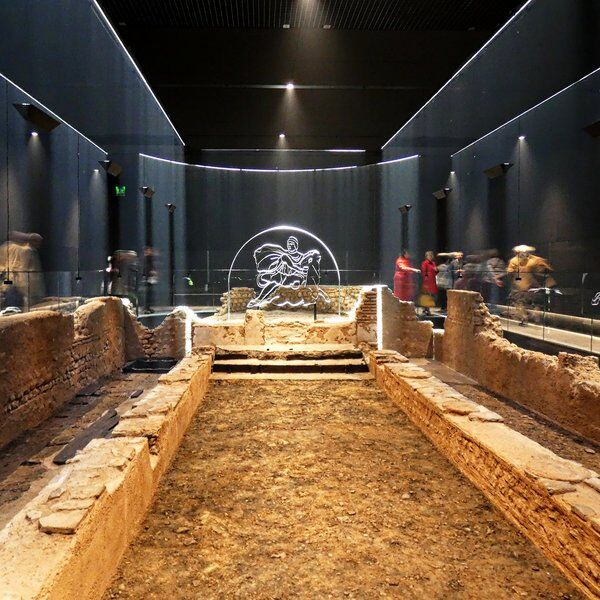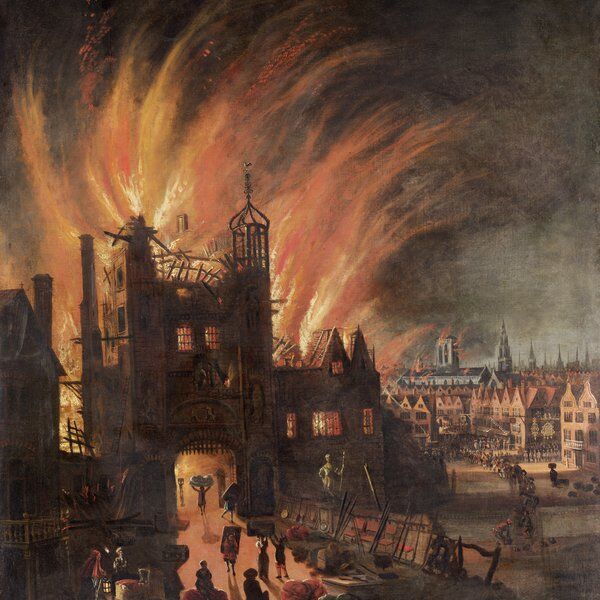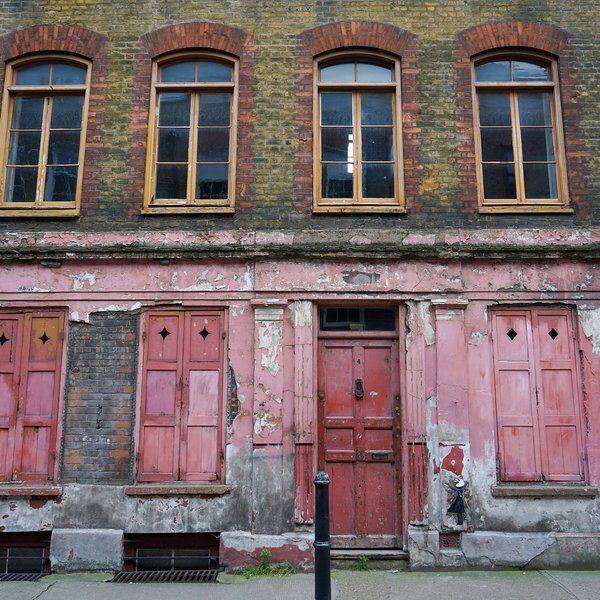A Victorian marketplace with Roman roots, Leadenhall Market is as old as London itself and carries the legacy of Londoners past and present.
Established in 1321, Leadenhall Market became one of London's most profitable and busiest markets in the United Kingdom. By the beginning the 19th century, Leadenhall Market was deemed unfit for purpose due to its ‘unruly and crowded’ stalls. Leadenhall market was redesigned by the city architect, Sir Horace Jones, and building commenced in 1881.
These days, Leadenhall Market is a prestigious grade II listed building containing boutiques, restaurants, cafés, pubs and wine bars. It is especially famous for featuring in the Harry Potter film franchise, Terry Gilliam, Lara Croft and for one special, previous resident of the market: Old Tom the Goose.
Most recently, Leadenhall Market featured in the Mario Kart 8 Deluxe DLC package, where players can race through a thoroughly charming Nintendo London.

Leadenhall Market & Harry Potter
The current market building - an iconic Victorian structure with wide, lamp-lit passages - has become a frequent fixture in Hollywood films. For Harry Potter fans though, visiting Leadenhall Market is practically an act of pilgrimage.
In the Harry Potter film franchise, Leadenhall Market was the set location for the filming of muggle London and Diagon Alley.
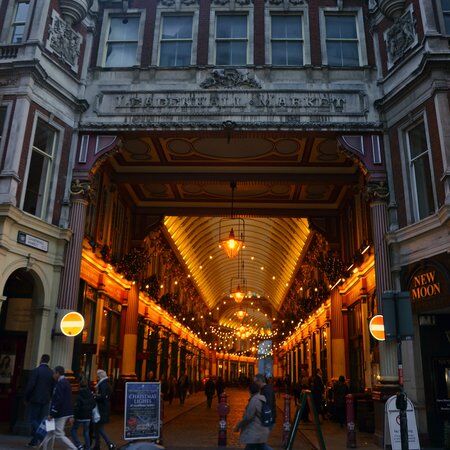
Harry Potter & The Leaky Cauldron Leadenhall Market Scene
Eagle-eyed fans of the Harry Potter movie franchise will recognise Leadenhall Market from two of the eight movies: Harry Potter and the Philosopher’s (Sorcerer's) Stone and Harry Potter and the Goblet of Fire.
In Philosopher’s (Sorcerer’s) Stone, the market is clearly visible during the scene in which Hagrid and Harry are walking towards The Leaky Cauldron pub, where the two use the passageway behind the inn to access Diagon Alley, the wizarding shopping high street.
The Leaky Cauldron’s (real life!) address is 42 Bull’s Head Passage and is actually an optician. The blue door that leads to the pub was also featured in Goblet of Fire.
Additional Diagon Alley Leadenhall Market Scene Fact: Although Leadenhall Market only appears in two of the movies, it wasn’t for a lack of trying.
Alfonso Cuarón, director of the third instalment in the series, Prisoner of Azkaban, wanted to capture the famous purple Knight Bus whizzing through Leadenhall Market. Mighty though the market is, it wasn’t big enough to fit a three-tiered model bus under it, so he was forced to change the set location to Stoney Street, Borough Market.
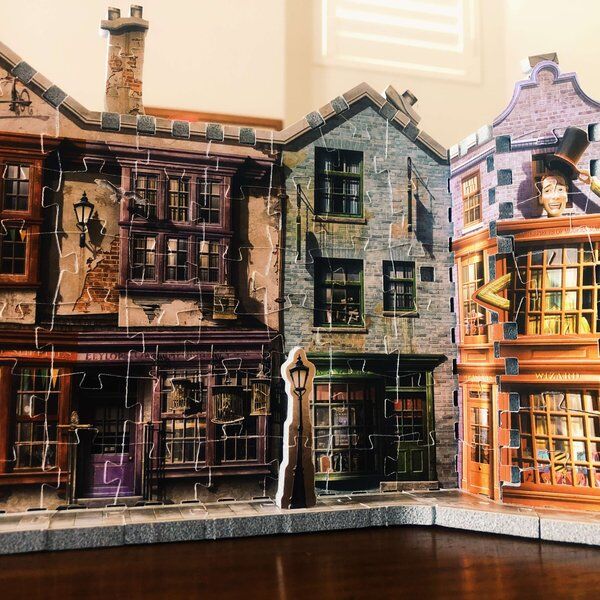
Diagon Alley Leadenhall Market
Although the author of Harry Potter, J.K Rowling, has never said that Leadenhall Market inspired the famous Diagon Alley, there are striking similarities to the Old Leadenhall Market and the wizarding street.
In 1880, just a few weeks into the remodelling of Leadenhall Market, The Illustrated London News published an article describing the Old Leadenhall Market as its readers would have known it:
“The scene in some of those narrow passages, with open shops at each end, under projecting caves and pent-houses constructed of massive woodwork, might remind one of the descriptions of an Eastern Bazaar…” – Illustrated London News, 18 September 1880
And if that doesn’t sound witchy enough to you, just look at what the newspaper tells us could be purchased there:
“All kinds of poultry, feathered game, hares and rabbits, carcasses of deer, and some fish, with bacon and sausages; live cocks and hens, pheasants, peacocks, ducks, geese; lap-dogs and fancy terriers; canaries, larks and other singing-birds are here offered for sale.” – Illustrated London News, 18 September 1880
Additional Diagon Alley Leadenhall Market Fact: The various plants studied by Hogwarts students in Herbology were inspired by Nicholas Culpeper’s guide to medicinal plants first published in 1652 as The English Physician. It was unusual because instead of being published in Latin, as most medical texts were at that time, it was written in English. It was also the first medical book published in North America.
In the illustrated versions of the books with artwork by Jim Kay, the artist’s interpretation of Diagon Alley includes an apothecary named Culpepper’s, just a few doors down from a pub he has jokingly named The Three Sheets (a nod to the typically British phrase “three sheets to the wind” meaning drunk).

Other Leadenhall Pop Culture References
Harry Potter isn't the only time Leadenhall Market has lit up the big screen, however. Its stunning arched corridors have also played a starring role in Terry Gilliam's The Imaginarium of Doctor Parnassus, Angelina Jolie's Lara Croft: Tomb Raider and Matt Damon's Hereafter.
And the market's celebrity doesn't end there. More than just a film location, it was also used for the music video of the Erasure hit, I Love To Hate You.
Fans of Mario Kart 8 can also ‘visit’ Leadenhall Market by playing the London Loop track, which was released on the 7th of December 2022 as DLC for the game on Nintendo Switch. London Loop is the first circuit in the Rock Cup, which may be a reference to 1960s and ‘70s British rock music, which features as the circuit’s soundtrack.
The first lap of the London Loop begins at Big Ben and passes London landmarks such as Nelson’s Column and Leadenhall Market.
A Wild Leadenhall Market Goose Chase?
From the beginning, Leadenhall Market was primarily a poultry market. Hundreds of thousands of birds were slaughtered over many hundred years there, but there was one whose name would be synonymous with Leadenhall Market for hundreds of years to come.
Reader, meet: Old Tom.
According to an edition of the Morning Advertiser, published on the 28th September 1864, Tom was “hatched at Ostend” and was “trained by M. Blaney, his owner, to act as a decoy goose” where he would lead his fellow geese to the wharf bound for London Markets for slaughter.
However, Old Tom would one day pay for the many hundreds of friends he had deceived. One day, by mistake, Tom boarded the fateful vessel with his doomed fellow geese and found himself at Leadenhall Market.
It was immediately clear to the Leadenhall Market poultry market owner, Mr. Glover, that Tom was no typical goose. Miraculously, Tom “would answer to his name in goosish dialect, and by a brisk clapping of his wings”. Some time later, Blaney, the goose’s original owner, came to Leadenhall Market and was instantly recognised by Tom, his beloved goose.
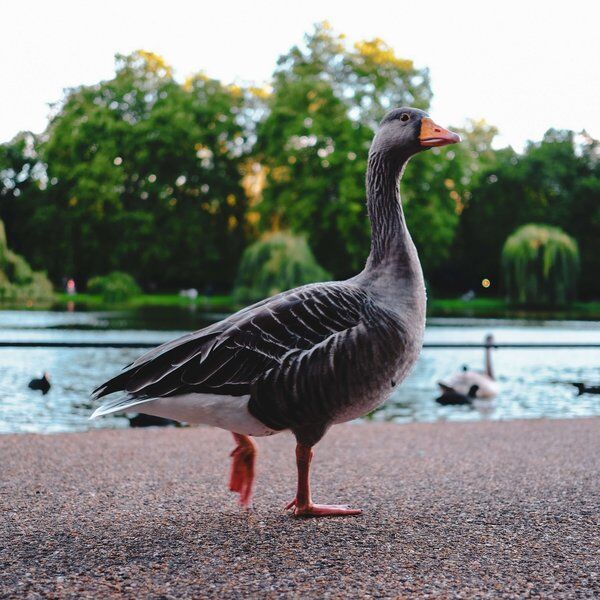
Overcome with emotion at this reunion, Blaney requested Mr. Glover to keep Tom alive, offering to pay all expenses associated with his feathered friend. Mr Glover agreed, though, Tom never had what one might call a typical goose’s life:
“He was accustomed to strut with great dignity into the Rose and Crown every morning, and ask, like any other customer, for his dram of mountain dew. By the time he had gone the round of the inns in the neighbourhood he would occasionally show himself the worse for his potations”.
Several times, apparently, Tom was apprehended by police for being drunk and disorderly.
The tale of Tom made its way around the market. He was celebrated as a goose amongst goslings. The market employees began to leave him scraps of food and he became a familiar face in the area.
He died in his nest at thirty-seven years old, but his legacy was to live on forever. His obituary appeared in London newspapers, his body was embalmed and he was even laid in state in Leadenhall Market, flanked by two geese “dressed in crape”.
Insider Tip: You can find Old Tom’s burial spot marked by the aptly-named Old Tom’s Bar.

The Ancient Origins of Leadenhall Market
Prior to Old Tom’s Victorian market, prior even to the 14th century origins of Leadenhall Market that preceded it, archeologists have found evidence that a Roman market existed on the very same site.
During Roman times, Leadenhall would have served as an integral part of Londinium (the Roman name for London). Archaeological evidence suggests that a settlement was established in and around Leadenhall Market in approximately 70 AD. This would have featured a basilica, a forum, a civic administration centre and, last but not least, a market.
Sadly, the Roman buildings were destroyed in 300 AD to punish the citizens of Londinium for supporting an anti-Roman uprising. The foundations of the Roman basilica can still be seen today, however, in the basement of the Nicholson and Griffin Barbershop in the market’s Central Avenue.
One More Thing…
As well as being a place of interest for film and history buffs alike, Leadenhall Market is also, well…a pretty good market. Open between the hours of 10am and 6pm, it remains a great place to buy such things as meat, cheese and flowers.
Pro Tip: Due to its close proximity to the London financial district, Leadenhall Market is almost always busiest on weekdays!
Want to explore Leadenhall Market and more London landmarks? Of course you do!
The best way to discover more hidden gems around Central London is to take your time and, ideally, have a pre-planned route that takes you past all the noteworthy nooks and hidden gems.
We can help you there!
The City combines the fun of an outdoor treasure hunt with the historic facts and whimsical trivia of a walking tour.
This route takes you through Leadenhall market and many other fascinating London landmarks, and will have you solving riddles, untangling puzzles and learning more about London’s 2000-year-old history in a new and interactive way - plus you get 20% off food and drink at a historic pub chosen by us!
Take the stress out of planning your visit to London and book your adventure today!
Not visiting Central London this time? Don’t worry, you’ll find us all over the world.
